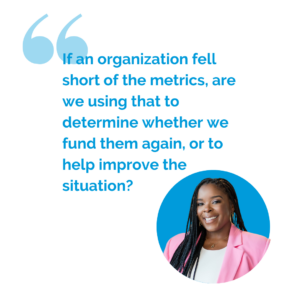I had the opportunity to sit down with one of those partners, April Walker, founder of Philanthropy for the People for an Elevate Q&A, the first in a series of blogs where we “pass the mic” to another member of our extended community to gain their personal perspective on issues relevant to the philanthropic sector and nonprofits. These conversations are exciting to Elevate as they lift up the opinions and expertise of our partners — which sometimes differs from the perspectives of Elevate’s leadership or readers. We believe that rich dialogue and difference of viewpoints makes this work more meaningful.
In my conversation with April, the first of our Elevate Q&A sessions, she shared her perspective and advice for organizations seeking to center equity and inclusion in their work. She also offered her thoughts on the limitations and challenges inherent in institutional philanthropy and fundraising – plus some advice for grant professionals and nonprofits. Here, I share some of the highlights of our discussion.
Institutional Philanthropy as an Imperfect Solution
Every day, nonprofits navigate the uncomfortable realities of power dynamics and disparities inherent in grantmaking. I asked some questions that explore these tension points and how it is possible to embrace an alternative value system while attempting to meet an organization’s budgetary needs.
Johnisha Levi: Institutional philanthropy is an imperfect solution to societal need, in part because it is the product of inequitable wealth transfers. Given this reality, what do we do to challenge and disrupt this system while society has yet to undertake the necessary systemic and structural reform to replace this entrenched system?
 April Walker: When I started in the field, folks were not quite as bold as they are now. Now they are starting to say, “Hey, you over there with all that wealth that you amassed in a problematic way, or that you inherited, we see a problem with that. And not only do we see a problem with that, we’re challenging that because we don’t trust exactly where the money came from, or we see that you’re limiting how you actually show up inside of the values you purport to have. We see that you’re asking us questions that you yourself don’t live by.”
April Walker: When I started in the field, folks were not quite as bold as they are now. Now they are starting to say, “Hey, you over there with all that wealth that you amassed in a problematic way, or that you inherited, we see a problem with that. And not only do we see a problem with that, we’re challenging that because we don’t trust exactly where the money came from, or we see that you’re limiting how you actually show up inside of the values you purport to have. We see that you’re asking us questions that you yourself don’t live by.”
So with the big players in the philanthropic space, it is getting harder and harder to celebrate the ways in which those dollars are exchanged. They’re not actually losing much, and the demands on celebrating and recognizing them are creating an additional strain for those of us who see the truth of what’s happening. It’s not necessarily an indictment of individual wealthy people or of all foundations of all sizes. but it is a request and growing demand for transparency. I think one of the biggest things that we can do is speak truth to power and not just placate, laud, and celebrate people for having huge amounts of resources at their behest—and with that act of calling out comes incredible amounts of power.
JL: When do you think the tide started to change in terms of calling out problems inherent in Philanthropy?
AW: I think within the past five years things have shifted. We’ve seen this as funders invite more conversations about diversity, equity, and inclusion by asking related questions of grantees. As a grant writer or grant professional, if you’re continually having to answer questions about how diverse or not a nonprofit’s board is, or how inclusive or not a program is from a funding entity that is none of those things, it is going to continue to expose these inequities.
JL: What is giving as its most ideal? What other models of giving do you recommend we look to for inspiration in our work and in our own lives as givers?
 AW: In proportion to what we have as a community and in proportion to what we have been able to amass on a large scale in terms of wealth, Black people are deeply generous. Sometimes it shows up financially, but there is also a generosity of time, of connection, of resources. Members of my family would likely never call themselves philanthropists, but have they put money into a pot to ensure a certain relative can achieve XY and Z dream? Absolutely. Is that a giving circle by the sector’s terms? Absolutely.
AW: In proportion to what we have as a community and in proportion to what we have been able to amass on a large scale in terms of wealth, Black people are deeply generous. Sometimes it shows up financially, but there is also a generosity of time, of connection, of resources. Members of my family would likely never call themselves philanthropists, but have they put money into a pot to ensure a certain relative can achieve XY and Z dream? Absolutely. Is that a giving circle by the sector’s terms? Absolutely.
I trust in the power of our ability to show up because you can pretend to care, but you can’t pretend to show up, whether that means showing up with a plate of food or showing up with $20 or just to lend a hand, and not even needing a thank you. All of that to me counts as generosity where I come from, and there’s a different type of connection in that than when money is at the center and you have to perform a certain way in order to even be in relationship.
Advice for Grant Professionals and Nonprofit Clients
JL: In a recent Cocktails, Conversations & Lessons in Philanthropy episode, you discussed funders’ need for public recognition and celebration and how that is frequently integrated into proposals. How do you recommend that grantees (and the fundraising consultants who work with them) respond to the common (and frankly uncomfortable) question of “How will you publicize our donation?”
AW: There are two applicable buckets. The first bucket is name recognition, or the literal benefits the funder receives for donating—what I call the five star treatment. The other bucket is a funder taking credit for stuff that they didn’t really do—meaning that funding an initiative through-and-through looks very different from making a non-profit apply every year. The former takes a long-term, sustained investment where people do not have to question if this money is going to run out. I wish quite frankly someone would do a case study of how much funders, especially corporate foundations or businesses in general, spend on ensuring that their investments look a certain way versus actually ensuring that their dollars are impactful.
Some grantees may decide that this recognition costs too much emotionally or mentally; other times, this may extend to telling the foundation this truth. It really comes down to being clear on how much risk your organization can assume. I’m also a huge advocate of telling other funders about their peers. I think at the end of the day, when you have a relationship with a funder who is deeply understanding—who does show up inside of their application in a way that’s not making you and your vision feel small—that it’s an opportunity to say, “Hey, I really appreciate your process for all of these reasons, and here’s how we also are engaging with other folks differently.”
JL: Funders are fixated on the idea of metrics and measurements, often to the detriment of smaller, less resourced organizations that are doing great work that is not necessarily measurable in the way that they demand. How do we evolve from this need to quantify? What have you seen other funders doing as an alternative? And how do we move away from the status quo?
 AW: There are funders that will ask for anecdotes in lieu of metrics or measurements, including asking for successes and challenges encountered. I quite prefer those questions. My personal and ever-growing feeling is that funders who want metrics should collect them themselves. Nonprofits need not be experts in all things. You want someone that’s really skilled in data analysis and measurement, if you as a funder have a specific focus on funding poverty in this local community, is it not incumbent upon you to collect the data that you need to prove that you are funding it in the right way? I don’t know many nonprofits that can pay a data expert what they’re worth.
AW: There are funders that will ask for anecdotes in lieu of metrics or measurements, including asking for successes and challenges encountered. I quite prefer those questions. My personal and ever-growing feeling is that funders who want metrics should collect them themselves. Nonprofits need not be experts in all things. You want someone that’s really skilled in data analysis and measurement, if you as a funder have a specific focus on funding poverty in this local community, is it not incumbent upon you to collect the data that you need to prove that you are funding it in the right way? I don’t know many nonprofits that can pay a data expert what they’re worth.
Nonprofits are interested in the data too—we want to know that we are doing the “thing”—but we are also interested in the reality of the thing and data doesn’t give us all of that narrative. The question is really one for funders to start asking themselves. Given you as the funder have set your own focus areas and funding priorities, how do you plan to go about getting that information from nonprofits that you can see are under-resourced? And even what funders do get from nonprofits is not always the most accurate, most comprehensive, complete story.
I’m also not sure what all these reports are telling people. As someone that used to be a program officer and received grant reports, even I had the question of, “What do we do now?” And if an organization didn’t meet the metrics, are we using that reality that they fell short of the metrics to determine whether or not we fund them again, rather than to determine how we can help improve the situation?
JL: Sometimes as individuals and organizations, we feel powerless to effect change when the problems are so massive. What are some steps or some work that you recommend we can still do to make a difference in our day-to-day work?
AW: Giving into hopelessness and giving up is not a path that we can choose. You have days that are challenging and demoralizing, but you can look up any number of leaders in the sector that remind us to be hopeful. Equal Justice Initiative’s Bryan Stevenson is a great example. And we do have wins along the way!
I’m also finding the people that I can link arms with. I’m not going to spend a huge amount of time on the people that are committed to moving slowly or delaying. I think your day-to-day has to find a balance between, “I have this capacity to fight, but when I feel like I’m at my wits end, I can turn back to the community that I know is bolstering me and take some strength from them.”
I also use my own philanthropy for this purpose. I support the organizations that I believe in and I know are doing good work and that I can trust, and that’s where I designate as much support as I can. I can also show up as a volunteer, I can show up as a board member, or I can just lend time to make an introduction. All of those things still matter inside of a system that is working to save itself, inside of whiteness as a construct that only knows how to defend itself. I have no qualms and no Illusions about how powerful the systems are, but I also won’t doubt my capacity for change and my capacity for impact.
Interested in learning more about alternative models of fundraising that are more community-centered? Check out the 10 principles of Community-Centric Funding developed by fundraisers of color that are grounded in racial and economic justice.
Keep your eye on this space for more ideas and strategies from April in the coming months as well as other Elevate Q&As.
About the Author:

Johnisha Levi










 April Walker
April Walker AW:
AW:  AW:
AW:




